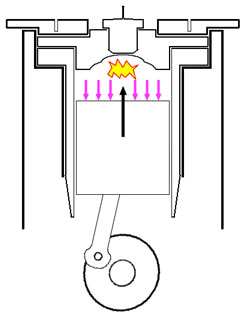
|
|
Welcome to the F2D News "How-To" Instructional Guide on: |
| Measuring and Setting an Engine's Head Clearance | ||||
|
|
Back | Page 3 of 3 | Next |
|
|
|
||||
| Guidelines for Adjusting Head Clearance | ||||
|
As a general rule, the lower the head clearance is, the harder it is on the engine. Because of this, it is wise to start off with a high head
clearance on a new engine. A fairly safe starting point is somewhere around 0.3 mm (0.012"). Once the engine has had a chance to break-in and if
it is not blowing glow plugs, then you might consider lowering the head by removing one shim to increase the power a bit. If this results in improved
performance without blowing glow plugs, you might try removing another shim. If the engine ever starts blowing plugs, however, you have gone too far
and must increase the head clearance back to a level at which the engine did not blow plugs. Furthermore, if pieces of the glow plug's element become
detached when it blows, you need to take the entire engine apart to clean out any remaining bits of the plug element before running it again. These pieces
could cause further permanent damage to the piston, liner, and bearings. Even if you use glow plugs with very thick elements that are less susceptible to breaking under extreme conditions, setting your compression ratio too high (i.e. head clearance too low) can still result in decreased power and possible harm to your engine. On the first page, I mentioned that the upward stroke of the piston compresses and heats the fuel/air mixture, bringing it to the verge of combustion. Under proper conditions, this mixture will not ignite until set off by the heat and catalytic properties of the glow plug coil at just the right moment when the piston reaches the top of its stroke. If the compression ratio is too high, however, the compression and heating of the upward stroke may set off the combustion reaction before the piston gets all the way to the top. This condition is called pre-ignition. When this happens, the pressure of the burning gases exerts a strong force downward on the piston while it is still traveling upward. This causes the piston to slow down, thus reducing performance, and puts a large stress on the piston and rod. Symptoms of pre-ignition include a characteristic sound, similar to a vibration noise, decreased power, and it can also leave the inner surface of the head button with a peppered, or sand-blasted appearance. That's about all I have to say about head clearances. This guide is meant to be just that -- a guide. I make no claims or guarantees about the information provided herein, and am not responsible for any injury or loss or damage of property that may occur as a result of following these instructions. I have made every effort to make these instructions as clear and accurate as possible, and hope that they have been useful to you. Thanks for reading! |
||||
|
|
||||
|
If you have any questions or comments, please email Mark at rudner@mit.edu |
||||
